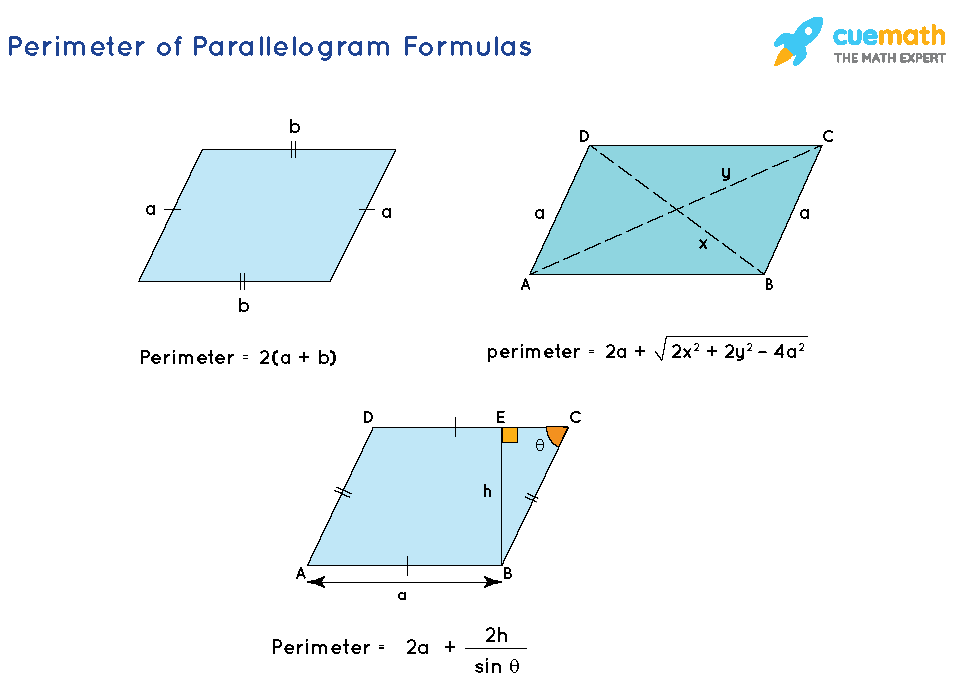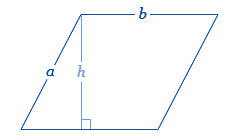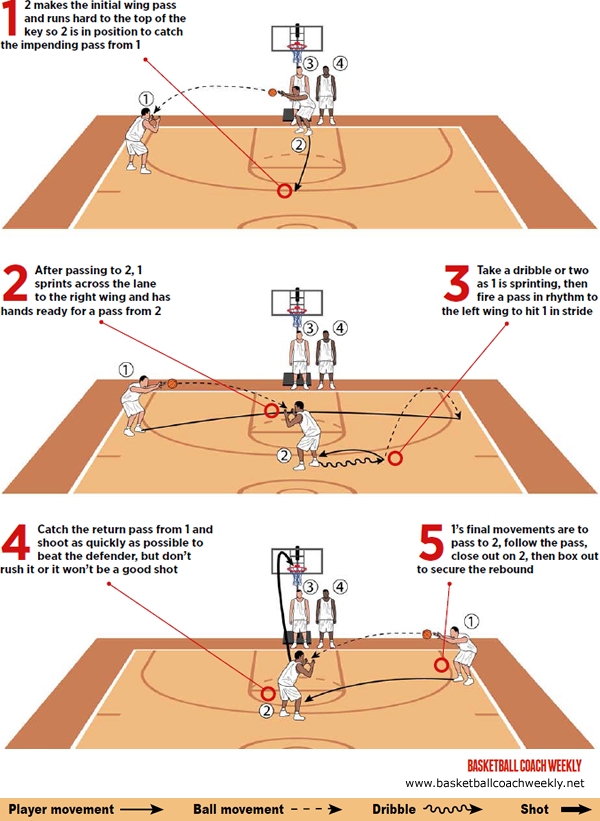Topic formula for the perimeter of a parallelogram: Unlock the secrets of geometry with our comprehensive guide on the formula for the perimeter of a parallelogram, a key concept in mathematics that bridges understanding and practical application.
Table of Content
Basic Formula for Parallelogram Perimeter
The perimeter of a parallelogram, a fundamental concept in geometry, is the total length of its boundary. To calculate it, we primarily use a simple and elegant formula: P = 2(a + b). Here, \"a\" and \"b\" represent the lengths of the adjacent sides of the parallelogram.
- Understanding the Sides: In any parallelogram, opposite sides are equal in length. Therefore, if one side is \"a\", the opposite side will also measure \"a\", and similarly for side \"b\".
- Applying the Formula: To find the perimeter, simply add the lengths of adjacent sides and multiply by 2. This is because the parallelogram has two sets of equal opposite sides.
For example, if a parallelogram has one side of length 5 cm and an adjacent side of length 3 cm, its perimeter would be calculated as follows:
- Identify the lengths of adjacent sides (a = 5 cm, b = 3 cm).
- Apply the formula: P = 2(a + b).
- Calculate: P = 2(5 cm + 3 cm) = 2(8 cm) = 16 cm.
This straightforward formula is effective in most situations. However, when the lengths of sides are unknown and other dimensions are given, alternative methods can be used, which will be explored in subsequent sections.

READ MORE:
Finding the Perimeter of a Parallelogram
\"Finding\" - Are you struggling to find the answers you\'re looking for? Watch this engaging video where experts share their tips and tricks to help you find what you\'re searching for with ease. Don\'t miss out on unlocking the secrets of successful finding!
Calculating the Perimeter of a Parallelogram
\"Calculating\" - Do numbers and equations confuse you? Fear no more! This video will guide you through the art of calculating step by step. Learn handy shortcuts and techniques that will make math a breeze. Join us for an exciting journey into the world of calculations!
Calculating Perimeter with Diagonals and One Side
Calculating the perimeter of a parallelogram when diagonals and one side are given involves a more advanced approach. This method is particularly useful in situations where the lengths of both adjacent sides are not readily available but the lengths of the diagonals and one side are known.
- Formula Derivation: The formula used in this case is derived from the law of cosines and properties of parallelograms. It is expressed as: P = 2a + √(2x² + 2y² - 4a²), where \"a\" is the length of the known side, and \"x\" and \"y\" are the lengths of the diagonals.
- Step-by-Step Calculation:
- Identify the known dimensions: side \"a\", and diagonals \"x\" and \"y\".
- Plug these values into the formula: P = 2a + √(2x² + 2y² - 4a²).
- Simplify the expression under the square root and then calculate the square root.
- Multiply \"a\" by 2 and add the result from step 3 to get the perimeter.
For instance, if a parallelogram has sides of length 6 cm, and diagonals of lengths 10 cm and 8 cm, the calculation would proceed as follows:
- Known dimensions: a = 6 cm, x = 10 cm, y = 8 cm.
- Substitute into the formula: P = 2(6) + √(2(10)² + 2(8)² - 4(6)²).
- Simplify and calculate the perimeter.
This method is a testament to the versatility and depth of geometry, offering solutions even when the typical data points are not available.

Finding Area and Perimeter of a Parallelogram
\"Area\" - Discover the fascinating world of measuring areas in this captivating video. Whether you\'re interested in geometry or simply want to expand your knowledge, this visual explanation will make understanding the concept of area a piece of cake. Don\'t wait, click play and explore the wonders of area measurement!
Perimeter Using Base, Height, and Angle
Calculating the perimeter of a parallelogram using the base, height, and an angle is a unique approach that utilizes trigonometry. This method is helpful when you have the base length, height from the base to the opposite side, and the measure of an angle of the parallelogram.
- Formula Overview: The formula used in this scenario is P = 2 × (a + (h/sin(angle))). Here, \"a\" is the base length, \"h\" is the height, and \"angle\" is the angle between the base and the side adjacent to the height.
- Step-by-Step Guide:
- Determine the base (a), height (h), and the angle measurement.
- Use the sine function of the given angle in the formula.
- Divide the height by the sine of the angle.
- Add this value to the base length and multiply by 2 to get the perimeter.
For example, if the base of a parallelogram is 10 units, the height is 5 units, and the angle is 30 degrees, the calculation would look like this:
- Base (a) = 10 units, Height (h) = 5 units, Angle = 30 degrees.
- Apply the formula: P = 2 × (10 + (5/sin(30 degrees))).
- Perform the calculations to find the perimeter.
This method illustrates the deep connection between geometry and trigonometry, providing an alternative route to finding the perimeter when traditional measurements are not available.

Understanding Parallelogram Properties
Grasping the properties of parallelograms is crucial for effectively applying formulas for their perimeter and area. A parallelogram, a significant shape in geometry, possesses unique characteristics that define its structure and help in solving various geometric problems.
- Opposite Sides Equal and Parallel: In a parallelogram, opposite sides are not only equal in length but also parallel to each other. This property is fundamental to understanding the shape\"s perimeter.
- Equal Opposite Angles: Another characteristic feature is that opposite angles in a parallelogram are equal. This helps in trigonometric calculations related to the shape.
- Supplementary Adjacent Angles: Each pair of adjacent angles in a parallelogram add up to 180 degrees, making them supplementary. This property is useful in various calculations involving angles.
- Diagonals Bisect Each Other: The diagonals of a parallelogram bisect each other. This property is often used in problems involving the internal structure and area of the parallelogram.
- Area Calculation: The area of a parallelogram can be calculated as the base multiplied by the height, another fundamental concept that is closely related to its perimeter.
Understanding these properties provides a solid foundation for solving a wide range of problems related to parallelograms, from calculating perimeters and areas to more complex geometric proofs and constructions.

Solved Examples
- Example 1: Find the perimeter of a parallelogram whose adjacent sides are 5 units and 9 units.
- Solution: The adjacent sides of the given parallelogram are a = 5 units and b = 9 units. Then its perimeter (P) is calculated as:
- P = 2(a + b)
- P = 2(5 + 9) = 2 × 14 = 28 units.
- Example 2: Find the perimeter of a parallelogram when one of its sides is 7 units and diagonals are 8 units and 10 units.
- Solution: Using the formula P = 2a + √(2x² + 2y² - 4a²) with a = 7, x = 8, y = 10, we get:
- P = 2 × 7 + √(2 × 8² + 2 × 10² - 4 × 7²) = 14 + √(128 + 200 - 196) = 14 + √132 ≈ 25.49 units (rounded to two decimal places).
- Example 3: The perimeter of a parallelogram is 48 cm and one of its sides is 16 cm. Find the length of the other side.
- Solution: Given: Perimeter (P) = 48 cm, and side a = 16 cm. Using P = 2(a + b), we find the length of the other side b:
- 48 = 2(16 + b) ⇒ b = 24 - 16 = 8 cm.
- Therefore, the other side of the parallelogram is 8 cm.
- Example 4: Find the perimeter of a parallelogram where one of its sides is 12 ft, its corresponding height is 8 ft, and one of the vertex angles is 30 degrees.
- Solution: Using the formula P = 2a + 2h / sin θ with a = 12 ft, h = 8 ft, θ = 30°:
- P = 2(12) + 2 × 8 / sin 30° = 48 + 16 = 64 ft.
- Thus, the perimeter of the parallelogram is 64 ft.

_HOOK_
READ MORE:
FAQs and Common Misconceptions
- Q1: Is the formula for the perimeter of a parallelogram the same as that of a rectangle?
- A: Yes, the formula for the perimeter of a parallelogram is similar to that of a rectangle, as both shapes have two pairs of parallel and equal sides. The perimeter is the total sum of all sides, calculated as P = 2(a + b).
- Q2: Can the perimeter of a parallelogram be calculated using only its diagonals?
- A: No, the diagonals alone are not sufficient to calculate the perimeter. However, if one side length is known along with the diagonals, the perimeter can be calculated.
- Q3: Is the height of a parallelogram always one of its sides?
- A: No, the height is not necessarily one of the sides. It is the perpendicular distance between the bases (opposite sides). Misunderstanding this can lead to incorrect calculations of the area and perimeter.
- Common Misconception: The base and height of a parallelogram are its adjacent sides.
- This is incorrect. The base is any of the sides, and the height is the perpendicular distance from this side to its opposite side, which may not be the length of an adjacent side.
- Common Misconception: The area and perimeter of a parallelogram are calculated in the same way.
- While the formulas might seem similar, they are used for different purposes. The perimeter is the sum of all side lengths, while the area is the product of the base and the height.
Discovering the formula for the perimeter of a parallelogram unlocks a world of geometric understanding. Embrace this journey through mathematics to enhance your problem-solving skills and uncover the beauty of geometric shapes in everyday life!












